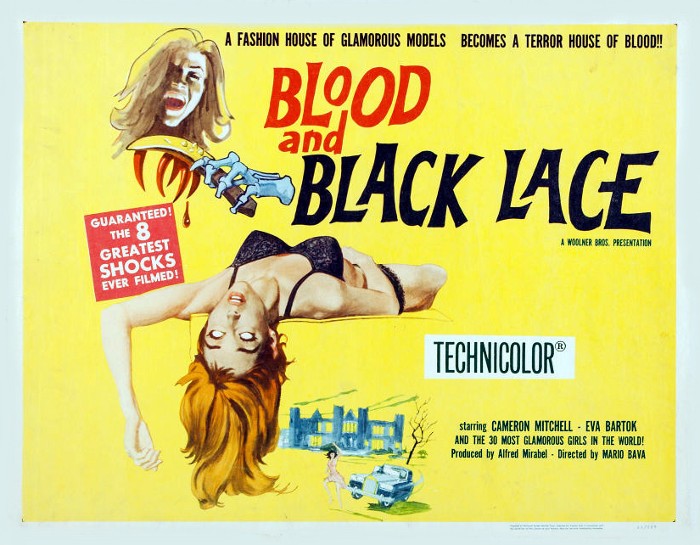The Girl Who Knew Too Much, in particular, has much in common with the giallo films which briefly proliferated the international market in the wake of Argento's international breakthrough, detailing as it does the amateur investigation of a foreigner into the work of a crazed killer. Overall, though, it's a light and jaunty film, and the suspense sequences tend to end in punchlines rather than murders. In Blood and Black Lace, Bava seems to have realised that gore and murder doesn't preclude an air of tongue-in-cheek fun, even when pushed to the forefront of the film. Here, the suspense sequences dominate, sharing the running time with by-the-numbers police procedural sequences.
These procedural sequences impose the structure of a plot on the film, but it's an extremely perfunctory one. The audience is denied the conventional identification figure, who screenwriting gurus and studio execs alike often claim is vital to the success of a film. Here, the audience is encouraged to identify with the director, or at least identify him as an extremely stylish and assured presence, and allow him to guide you through the 8 greatest shocks ever filmed, as the above poster would have it (the 8th shock is presumably the realisation at the end of the film that only 7 characters have died).
The murder sequences are masterworks all; a heady mix of brilliantly controlled camerawork, daringly expressionistic lighting, and just enough of a sense of fun to make the many and varied horrors visited upon the cast of women digestible (I do say that as a male man; and that's to say nothing of the refusal of any character to even countenance the possibility that a woman can be anything but a victim, as shown by the rounding up of all suspects, AKA every male connected with the fashion house). They have a different feel to much of Argento's set pieces, with the lighting and camera movement to the fore, whereas Argento, in his gialli at least, tended to favour editing and music. A couple of tracking shots, one across a large room towards a body lying behind a screen, and another which eases mannequins aside as the camera hones in on the final murder victim, almost have the weight of the point-of-view shots which proliferated in the slasher films, with the camera becoming an active agent in the mayhem.
The form the film takes, with the procedural scenes linking a series of murder set-pieces, with no one character at the centre of things, suggests a refinement of the genre which is almost redolent of the neo-giallo films, which tend to eschew the murder-mystery aspect of the classic examples of the genre. Nonetheless, there is a murder-mystery at the heart of this film, and by dispensing with the audience identifier, or cipher, one could argue that Bava tasks the audience themselves with discerning the killer's identity. After all, when it comes down to it, the viewers of murder-mysteries tend to actively engage with the film by guessing at the killer's identity themselves, and don't just sit back and let the characters figure things out. By clearing the cipher character out of the way, Bava leaves more room, and time, for his playful but deadly murder scenes.
The ultimate revelation as to the killer's' identityies gives rise to a very interesting question regarding just how active audiences want to be when watching films. Older, more traditional murder mysteries in the Agatha Christie-vein often offered up a series of clues, which an alert viewer could piece together to uncover the killer's identity (although the best examples would tend to include some misdirection, so that the clues only come to the fore in retrospect). The giallo tended to take a different approach, by presenting clues which are deliberately designed to confuse and obfuscate, with the killer's unmasking being a shocking twist. Of course, once you've watched several of them, you can take all the red herrings the films present as clues, in that the one character who isn't offered up as a potential suspect is the killer-by-default. Blood and Black Lace for the most part follows (or creates) this giallo template, for one of the killers at least, and a seasoned fan of the genre may be able to distil an important clue from some casually introduced character backstory towards the film's beginning, but the reveal is essentially designed to be unguessable. It is guessable, of course, in that there are a finite number of suspects and motives, and plenty of people have probably got it right over the years, but they probably only have the law of averages to thank for that.
Finally, it's worth pointing out that money is the prime motivation behind the murders, as it was for most of the 60s gialli, These films form an interesting bunch, as they don't quite conform to a template in the way that the post-Argento films do. Many of them are situated on the furthest reaches of the genre, if they fall within its boundaries at all. There were a series of films which did follow a basic trend, though, (The Sweet Body of
|
|
Deborah, Forbidden Photos of a Woman Above Suspicion, So Sweet... So Perverse). Ernesto Gastaldi and Umberto Lenzi, who were at the forefront of these early gialli, seemed to take the last twenty minutes of Blood and Black Lace as the basis for a series of films based around inheritances and deception. The aim was usually to drive a rich person to madness, to get at their money. Argento, in his genre-defining films, took Bava's ostentatious set pieces, pushed money to one side, and let the madness take control.
|

 RSS Feed
RSS Feed
